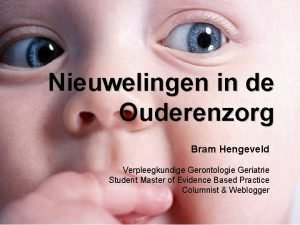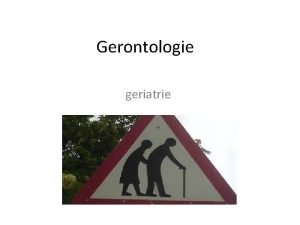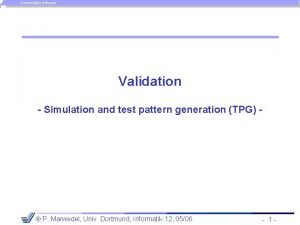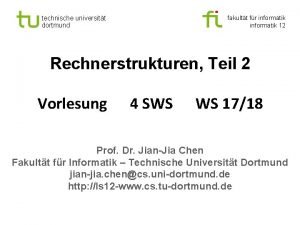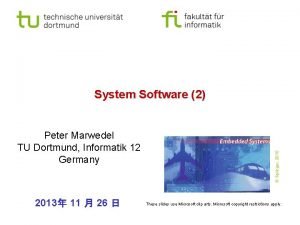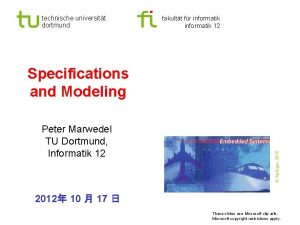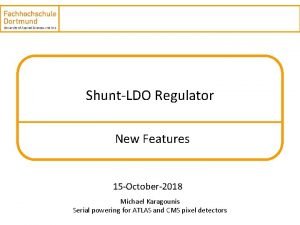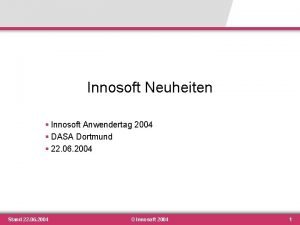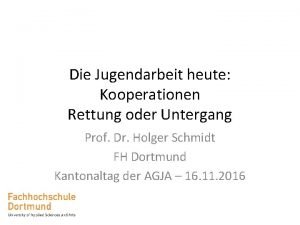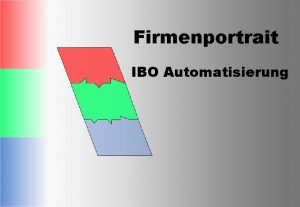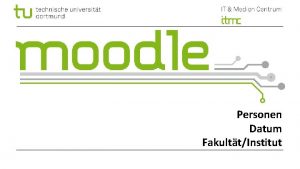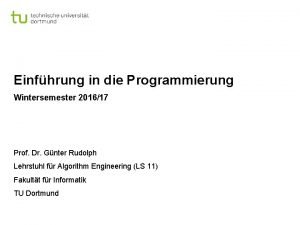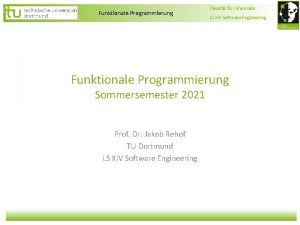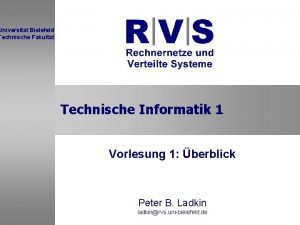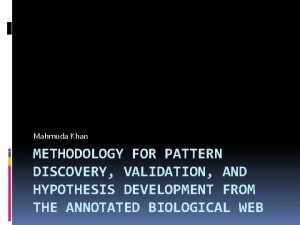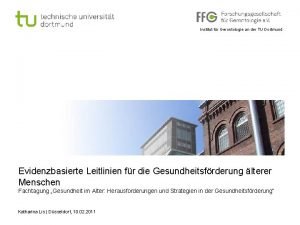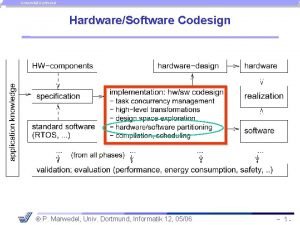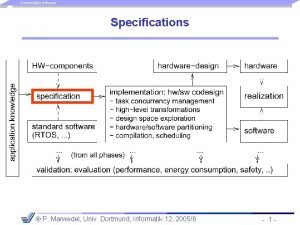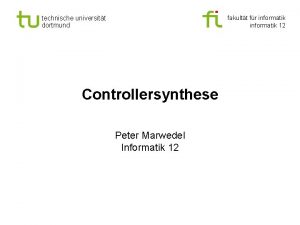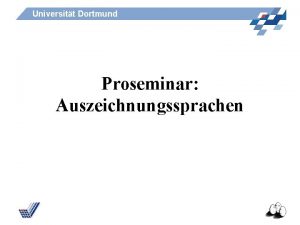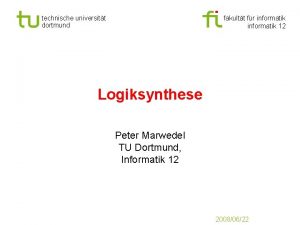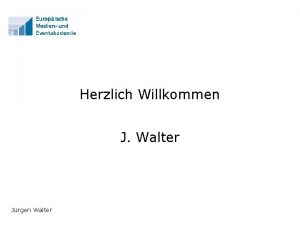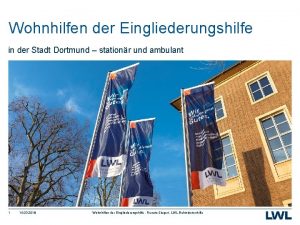Institut fr Gerontologie an der TU Dortmund Jrgen





























- Slides: 29

Institut für Gerontologie an der TU Dortmund Jürgen Bauknecht* | Andreas Cebulla^ | Mikkel Barslund° * Institute of Gerontology at TU Dortmund University ^ SA Centre for Economic Studies, University of Adelaide ° Centre for European Policy Studies, Brussels Working conditions and retirement: how important are HR policies in prolonging working life? ‘Work, Age and Employment – Evidence from Longitudinal Studies (WAHE 2016)’ University of Wuppertal, Germany, September 21 st 2016

Institut für Gerontologie an der TU Dortmund Contens § § § 1. Working conditions and longer working lives 2. State of research for 9 work satisfaction components 3. Data 4. Results 1 – 5 5. Evaluation of maximum effects 6. Summary and conclusions 2

Institut für Gerontologie an der TU Dortmund 1. Working conditions and aspects of longer working lives § Macro (primarily national policies) Pensions, unemployment, disability, subsidies/tax breaks § Meso (companies/organisations, social partners) Labour supply (e. g. workability-measures for health, skill development, motivation) § Labour demand Field of action Empirical basis § Micro (not as field of action) Determinants e. g. family status, health status, attitudes Meso level measures → micro level factors → retirement behaviour 3

Institut für Gerontologie an der TU Dortmund HR components → retirement/not 4

Institut für Gerontologie an der TU Dortmund 2. Work satisfaction components My job is physically demanding. I am under constant time pressure due to a heavy workload. I have very little freedom to decide how I do my work. I have an opportunity to develop new skills. I receive adequate support in difficult situations. I receive the recognition I deserve for my work. Considering all my efforts and achievements, my [salary is/earnings are] adequate. My [job promotion prospects/prospects for job advancement] are poor. My job security is poor. 5

Institut für Gerontologie an der TU Dortmund 2. State of research (1/6) 1. Job is physically demanding → early labour market exit (8 longitudinal quant. studies, van den Berg et al. 2010) → disability retirement (Krause et al. 1997) → retirement intentions (for job demands and emotional demands, Burke et al. 2012) → recovery needs and following labour market exit (Schreur et al. 2011) → early retirement (Szubert/Sobala 2005) → disability retirement due to musculosceletal diseases (Lahelma et al. 2012) → weaker effects on early retirement intentions than mentally demanding work (von Bonsdorff et al. 2010) → no evidence for work exit (Carr et al. 2016) → no evidence for retirement intentions (Henkens/Leenders 2010) → no significant effects on labour market participation (Fleischmann et al. 2013) → evidence for any kind of early retirement only for women, for disability retirement men and women (Blekesaune/Solem 2003) 6

Institut für Gerontologie an der TU Dortmund 2. State of research (2/6) 2. Time pressure → lower probability of bridge employment (Wang et al. 2008) → frequent deadlines and time pressue lead to disability exit (Krause et al. 1997) → work overload leads to early retirement intentions (Burke et al. 2012) → autonomy over work pace increases probability of labour market participation (employed or unemployed in contrast to e. g. being retired, Fleischmann et al. 2013) → job demand index (2/4 variables on time pressure) no considerable effects on early retirement for men, and statitsically insignificant for women (Mein et al. 2000) → effects of job pressure only on early retirement intentions but not on early retirement (van Solinge/Henkens 2013) → effects on workload on early retirement intentions not significant, possibly due to the inclusion of ‚burnout factors‘ (Henkens/Leenders 2010) → no effect from ‚psychsocial demands‘ (incl. fast work and time pressure) on labour market exit (Carr et al. 2016) 7

Institut für Gerontologie an der TU Dortmund 2. State of research (3/6) 3. Very little freedom to decide how to do work → job control negatively affects early retirement intentions (Elovainio et al. 2005) → job control foster work enjoyment which lower early retirement intentions (Schreur et al. 2011) → Low job control increases likelihhod of depressive symptoms which fosters early retirement (Lunau et al. 2013) → decision authority negatively affects work exit (Carr et al. 2016) → job control lowers probability of disability due to musculoskeletal diseases and especially mental disorders (Lahelma et al. 2012) → autonomy over work fosters probability to be in work or unemployed (Fleischmann et al. 2013) → no significant association between low autonomy and expected retirement age, but low-n (Beehr et al. 2000) → no effects of autonomy on later retirement (Henkens/Lenders 2010) → effect of autonomy on willingnes to continue to work not signficant, but low-n (Shacklock/Brunetto 2008) 8

Institut für Gerontologie an der TU Dortmund 2. State of research (4/6) 4. Opportunity to develop new skills → no results found so far 5. Adequate support in difficult situations → negative effect of co-worker support on disability retirement insignificant but signficant with supervisor support (Krause et al. 1997) → effect on early retirement intentions but weak on actual retirement behaviour (van Solinge/Henkens 2013) → low social support fosters labour market exit (disability physical/mental see above) (Lehalma et al. 2012) → low social support fosters early labour market exit, but unstable significance (Carr et al. 2016) 9

Institut für Gerontologie an der TU Dortmund 2. State of research (5/6) 6. Recognition considered adequate and 7. Earnings considered adequate → negative effort-reward imbalance and negative assessment of justice harms health (Kivimäki et al. 2007, Fischer/Sousa-Poza 2007, Lunau et al. 2013 for depression). Since health affects retirement behaviour (e. g. Wang et al. 2008, Behr et al. 2000, Szubert/Sobala 2005) subjective negative injustice foster labour exit 8. Promotion prospects poor → also part of justice in 6. and 7. , Kivimäki et al. 2007) → Subjective promotion prospects, opportunities for growth and absence of feeling of dead end delays retirement (van Solinge/Henkens 2013) → negative effects of opportunities for growth on early retirement intentions (Henkens/Leenders 2010) 10

Institut für Gerontologie an der TU Dortmund 2. State of research (6/6) 9. Job security is poor → job insecurity as main driver of early retirement (Winter-Ebmer et al. 2011) → fear of losing job delays retirement (Debrand/Sirven 2009) 11

Institut für Gerontologie an der TU Dortmund HR components → job satisfaction → retirement/not 12

Institut für Gerontologie an der TU Dortmund 3. Data § SHARE § § 1 2 4 5 2004 2007 2011 2013 13

Institut für Gerontologie an der TU Dortmund 4. Results (1/5) How well does HR component predict overall job satisfaction? (Odd ratios going from worst to best, ordered logit [<1 neg]). IV turned to positive direction Physical demanding 0. 9 Time pressure 1. 45** Little freedom 2. 26*** Develop new skills 2. 73*** Support 1. 98*** Recognition 5. 31*** Salary Prospects for promotion Job security 2. 9*** 1. 08 2. 22*** N=23, 791, 75 > age >=50, employed. **: p = 0. 05, ***: p = 0. 001 14

Institut für Gerontologie an der TU Dortmund 4. Results (2/5) Most people ‚satisfied‘ or ‚very satisfied‘ with job Satisfied with job High education Low education 50 -54 55 -59 Strongly agree 48 51 39 40 Agree 46 41 51 52 Disagree 5 6 7 6 Strongly disagree 1 2 3 2 SHARE wave 1, 2004. 15

Institut für Gerontologie an der TU Dortmund 4. Results (3/5) Average number of years worked after 2004, 50 -54 (descriptive, no controls) Maximum 9 years (for data reasons 2004 – 2013) Satisfied with job High edu Low edu 50 -54 55 -59 Strongly agree 6. 8 5. 2 6. 3 4. 4 Agree 6. 4 4. 7 5. 9 4. 3 Disagree 4. 9 5. 2 4. 0 Strongly disagree 5. 2 6. 2 5. 2 2. 7 SHARE various waves. Low number of observations in ‚disagree‘ and ‚strongly disagree‘ cells 16

Institut für Gerontologie an der TU Dortmund 4. Results (4/5) Effect of overall work satisfaction on number of years worked (2004, 2007, 2011, 2013) Working years (one of several specifications with similar results) Average number of years worked for 50 -54 y/o: 7. 1 50 -54 y/o Base 55 -59 y/o -3. 7*** 60 -64 y/o -6. 6*** Women -0. 3*** Strongly dissatisfied Base Dissatisfied -0. 01 Satisfied 0. 41* Strongly satisfied 0. 63** Controls for interview year and country N=20, 201, 50<= age <65. SHARE various waves. + 0. 63 years = 7. 5 months 17

Institut für Gerontologie an der TU Dortmund 4. Results (5/5) Percentage wanting to retire ‘as early as possible’ by education, work satisfaction and age groups, age 50 -75. Very low n in ‘disagree’ ‘strongly disagree’ espc. Older groups → even amongst those satisfied a high share wants to quit asap 18

Institut für Gerontologie an der TU Dortmund 5. Evaluation of maximum effects (1/4) Rise of the legal retirement age § DE: + 2 years: Simulation analysis: ~ 11 months later retirement [Fehr et al. 2010] § § DE: Rise of statutory retirement age and of early retirement age by 2 years: Projection: men + 9 months (based on old system) [Berkel/Börsch-Supan 2004] NL: Rise (public sector workers) by 1 year: Retirement expectations + ~ 7 months by 2 year: Retirement expectations + ~ 11 months (men 7 months, women 17 months, largely due to higher incomes amongst men, who can afford pension cuts due to earlier retirement. Also weak effects amongst those with pension entitlements in the 2 nd and 3 rd pillar [de Grip et al. 2013] § ES: Rise of statutory retirement age from 65 to 68: Projection: + 20 months [Díaz-Giménez/Díaz-Saavedra 2009, 2014]. 19

Institut für Gerontologie an der TU Dortmund 5. Evaluation of maximum effects (2/4) Rise of the legal retirement age § US: + 2 months: Projection: + 1 month or 12/18 months for 2/3 years [Mastrubuoni 2006] § § FI: Rise of entry age in regular pension, part-time pension and the unemployment tunnel by 2 years: Projection: + 6 months [Määtänen 2014] FI: Rise of the retirement corridor 63 -68 → 65 -70. Projection: + 1 -2 years [Tikanmäki et al. 2015] § Benefit rises for later retirement ES: Rise of retirement benefits due to longer working lives actuarilly fair, so not 3% at age 65 but ~ 7% annually and rising to 15. 6% at age 80: Projection: + 6 working months [Díaz-Saavedra 2015] 20

Institut für Gerontologie an der TU Dortmund 5. Evaluation of maximum effects (3/4) Retirement: Other issues § ES: Complete removal of restrictions to combine work with pension income: Projection: + 2. 7 working years [Díaz-Saavedra 2015] Unemployment benefits § FI: Higher age threshold for extended unemployment benefits (55 → 57): Large drop in unemployment between 55 and 59 (25 000 → 10 000) between 2005 and 2009, (Braconier 2010), later labour market exit by + 1. 3 months [Kyyrä 2010] 21

Institut für Gerontologie an der TU Dortmund 5. Evaluation of maximum effects (4/4) Disability schemes § § DE: Closure of disability insurance exit pathway: Projection: + 7 months for men and 2. 5 months for women [Jürges et al. 2014] FI: Abolishment of disability scheme ‚individual early retirement‘ (has been done for those born after 1943): Projection: + 3. 4 working months [Kyyrä 2015] 22

Institut für Gerontologie an der TU Dortmund 6. Summary and Conclusions § § Strong effects for small group of dissatisfied Weak effects for large group of satisfied workers § § Effects dwarfed by policy reforms But in contrast to policy reforms´ effects, positive HR effects important in themselves and do not come with disadvantages 23

Institut für Gerontologie an der TU Dortmund Dr. Jürgen Bauknecht jbauk@post. tu-dortmund. de ++49 (0) 231 728488 -15 Dr. Andreas Cebulla andreas. cebulla@adelaide. edu. au ++61 (0)8 83130013 Dr. Mikkel Barslund mikkel. barslund@ceps. eu ++32 2 229 39 49

Institut für Gerontologie an der TU Dortmund 7. References (1/5) § § § § Beehr, T. A. , Glazer, S. , Nielson, N. L. , Farmer, S. J. (2000), ‘Work and Nonwork Predictors of Employees´ Retirement Ages’, Journal of Vocational Behavior 57, 206 -225 Berkel, B. , Börsch-Supan, A. (2004): Pension Reform in Germany. The Impact on Retirement Decisions, MEA Discussion Paper 62 -2004. Mannheim. Blekesaune, M. , & Solem, P. (2005). Working conditions and early retirement: A prospective study of retirement behaviour. Research on Ageing, 27(1), 3 − 30. Braconier, H. (2010): Coping with the Job Crisis and Preparing for Ageing: The Case of Finland. OECD Economics Departmnet Working papers, No. 7778, OECD Publishing. Burke, R. , Dolan, S. L. , Fikesenbaum, L. (2012), ‘Predictors of the decision to retire among nurses in Spain: A descriptive survey’, International Journal of Nursing, 1(2), 2012, 25 -32. Carr, E. , Hagger-Johnson, G. , Head, J. , Shelton, N. , Stafford, M. , Stansfeld, S. , Zaninotto, P. (2016): Working conditions as predictors of retirement intentions and exit from paid employment: a 10 -year follow-up of the English Longitudinal Study of Ageing. European Journal of Ageing, Vol. 13 (1), 39 -48. Debrand/Sirven 2009 de Grip, A. /Fouarge, D. /Montizaan, R. (2013): How Sensitive are Individual Retirement Expectations to Raising the Retirement Age? De Economist (2013), 161, 225 -251. 25

Institut für Gerontologie an der TU Dortmund 7. References (2/5) § § § § Díaz-Giménez, J. /Díaz-Saavedra, J. (2009): Delaying retirement in Spain. Review of Economic Dynamics 12 (2009), 147 -167. Díaz-Giménez, J. /Díaz-Saavedra, J. (2014): The Future of Spanish Pensions. Dpto. Teoría e Historia Económica Universidad de Granada, Working Paper n. 14/03, May 2014. Díaz-Saavedra, J. (2015): Tax and Transfer Programs, Retirement Behavior, and Work Hours Over the Life Cycle. Journal of European Policy Reform. Elovainio et al. 2005 Fehr, H. /Kallwit, M. /Kindermann, F. (2010): Pension reform with Variable Retirement Age – A Simulation Analysis for Germany. Journal of Pension Economics and Finance, 11 (3), 389– 417. Fischer, J. A. V. , Sousa-Poza, A. (2007), ‘Does Job Satisfaction Imrpove the Health of Workers? New Evidence Using Panel Data and Objective Measures of Health’, IZA Discussion Paper No. 3256. Fleischmann, M. , Koster, F. , Dykstra, P. , Schippers, J. (2013), ‘Hello pension, goodbye tension? The impact of work and instituions on older workers´ labor market participation in Europe. International Journal of Ageing and Later Life, 2013, Vol. 8 (2), 33 -67. Henkens, K. , Leenders, M. (2010), Burnout and older workers´ intentions to retire. International Journal of Manpower, 31, (3), 306 -321. 26

Institut für Gerontologie an der TU Dortmund 7. References (3/5) § § § Jürges, H. /Thiel, L. /Bucher-Koenen, T. / Rausch, J. / Schuth, M. / Börsch-Supan, A. (2014): Health, financial incentives, and early retirement: Micro-simulation evidence for Germany. Schumpeter Discussion papers, No. 2014 -003, urn: nbn: de: hbz: 468 -20140206 -112013 -6. Kivimäki, M. , Vahtera, J. , Elovainio, M. , Virtanen, M. , Siegrist, J. (2007), ‘Effort-reward imbalance, procedural justice and relational injustice as psychosocial predictors of health: complementary or redundant models? Occupational & Environmental Medicine, 64, 659 -665. Krause, N. , Lynch, J. , Kaplam, G. A. , Cohen, R. D. , Goldberg, D. E. , Salonen, J. T (1997): ‘Predictors of disability retirement’, Scandinavian Journal of Work, Environment Health, 1997, 23 (6), 403 -413. Kyyrä, T. (2010): Partial unemployment insurance benefits and the transition rate to regular work. European Economic Review 54 (2010), 911 -930. Kyyrä, T. (2015): Early retirement policy in the presence of competing exit pathways: Evidence from pension reforms in Finland. Economica, 82, 46– 78. Lahelma, E. , Laaksonen, M. , Lallukka, T. , Martikainen, P. , Pietiläinen, O. , Saastamoinen, P. , Gould, R. , Rahkonen, O. (2012). , ‘Working conditions as risk factors for disability retirement: a longitudinal register linkage study. BMC Public Health. 2012; 12: 309. http: //dx. doi. org/10. 1186/1471 -2458 -12 -309. 27

Institut für Gerontologie an der TU Dortmund 7. References (4/5) § § § Lunau, T. , Wahrendorf, M. , Dragano, N. , Siegrist, J. (2013), ‚Work stress and depressive symptoms in older employees: impact of national labour and social policies. BMC Public Health, Vol. 13, 1086, [Pub. Med: 24256638] Määtänen, N. (2014): Evaluation of Alternative Pension Policy Reforms Based ona Stochastic Life Cycle Model. In: Lassila, Jukka/Määtänen, Niku/Valkonen, Tarmo (eds. ): Linking retirement age to life expectancy – what happens to working lives and income distribution? Finnish Centre For Pensions Reports ETLA B 260, 2/2014, 17 -52. Mastrubuoni, G. (2006), Labor Supply Effects of the Recent Social Security Benefit Cuts: Empirical Estimates Using Cohort Discontinuities. CEPS Working Paper No. 136 Mein, G. , Martikainen, P. , Stansfeld, S. A. , Brunner, E. J. , Fuhrer, R. , Marmot, Mi. G. (2000), Predictors of early retirement in British civil servants, Age and Ageing 2000, (29), 529 -536. Schnalzenberger, M. , Schneeweis, N. , Winter-Ebmer, R. , Zweimüller, M. (2011), Job Quality and Employment of Older People in Europe, The Austrian Center for Labor Economics and the Analysis of the Welfare State Working Paper No. 1105. Schreurs, B. , de Cuyper, N. , van Emmerik, I. J. H. , Notelaers, G. , de Witte, H. (2011), ‘Job demands and resources and their associations with early retirement intentions through recovery need and work enjoyment’, SA Journal of Industrial Psychology/SA Tydskrif vir Bedryfsielkunde, 37 (2), Art. #859, 11 pages. 28

Institut für Gerontologie an der TU Dortmund 7. References (5/5) § § § § § Shacklock, K. , Brunetto, Y. (2008), ‘A model of older workers´ intentions to continue working’, Personnel Review, 40(1), 252 -274. Szubert, Z. , Sobala, W. (2005), ‘Current determinants of early retirement among blue collar workers in Poland’, International Journal of Occupational Medicine & Environmental Health, 18(2), 177 -184. Tikanmäki, H. /Sihvonen, H. / Salonen, J. (2015): Distributional Effects of the Forthcoming Finnish Pension Reform – a Dynamic Microsimulation Approach. International Journal of Microsimulation, 8 (3), 75 -98. van den Berg et al. 2010 Van Solinge, H. , Henkens, K. (2013): Work-related factors as predictors in the retirement decision-making process of older workers in the Netherlands. Ageing & Society 34 (9), 11511174 von Bonsdorff et al. 2010) Wang et al. 2008, Wang, M. , Zhan, Y. , Liu, S. , Shultz, K. S. (2010), ‚Antecedents of Brdige Employment: A Longitudinal Investigation‘, Journal of Applied Psychology, 2008, Vol. 93, No. 4, 818 -930. Winter-Ebmer et al. 2011 29
 Master gerontologie
Master gerontologie Geriatrie a gerontologie rozdíl
Geriatrie a gerontologie rozdíl Thermico dortmund
Thermico dortmund Rechnerstrukturen tu dortmund
Rechnerstrukturen tu dortmund Dortmund pattern
Dortmund pattern Tu dortmund rechnerstrukturen
Tu dortmund rechnerstrukturen Rechnerarchitektur tu dortmund
Rechnerarchitektur tu dortmund Lsf fh dortmund
Lsf fh dortmund Srp tu dortmund
Srp tu dortmund Technische informatik definition
Technische informatik definition Michael karagounis
Michael karagounis Mmi tu dortmund
Mmi tu dortmund E3t tu dortmund
E3t tu dortmund Brandschutzpiktogramme
Brandschutzpiktogramme Memory z dortmund
Memory z dortmund Innosoft einsatzplanung
Innosoft einsatzplanung Boss tu dortmund
Boss tu dortmund Holger schmidt fh dortmund
Holger schmidt fh dortmund Ostrzenski dortmund
Ostrzenski dortmund Tu dortmund unimaik
Tu dortmund unimaik Wgh dortmund
Wgh dortmund Studentensekretariat tu dortmund
Studentensekretariat tu dortmund Pikas uni dortmund
Pikas uni dortmund Technische lego
Technische lego Ub dortmund
Ub dortmund Dortmund arbeitslosenquote
Dortmund arbeitslosenquote Retina tu dortmund
Retina tu dortmund Funktionale programmierung tu dortmund
Funktionale programmierung tu dortmund Hazardfehler
Hazardfehler Zubair khan dortmund
Zubair khan dortmund
